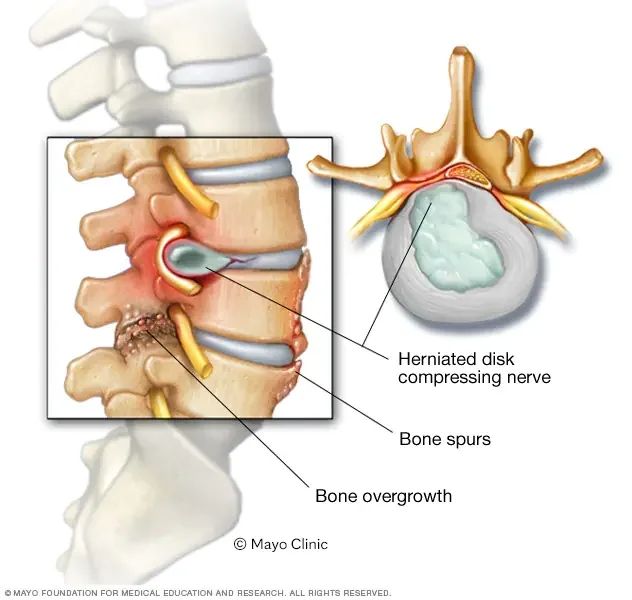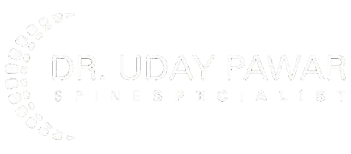Spinal Stenosis Treatment
in Mumbai
When we were young, fitting three students on a single school bench was manageable. But what if a fourth student squeezed in? It would feel cramped, with limited space to move. This analogy explains spinal stenosis. It occurs when the space within your spine narrows, pinching the spinal cord and nerves.

This can cause pain, numbness, or weakness in the back or legs. Spinal stenosis, particularly in the lower back, can be a significant concern if left untreated.
The good news is that effective spinal stenosis treatment options are available in Mumbai. If you’re experiencing symptoms of spinal stenosis and seeking relief, look no further. Dr. Uday is a skilled spinal stenosis specialist in Mumbai.
Symptoms of Spinal Stenosis
Spinal stenosis is a condition that occurs when the space within the spinal canal narrows, pinching the spinal cord and nerves that travel through it. Imagine the spinal canal as the highway for your nerves. In spinal stenosis, the traffic lanes become congested, causing disruptions in communication between your brain and the rest of your body.
Pain
This is the most common symptom of spinal stenosis. You might experience:
Lower back or buttock or leg pain on activity
This is especially common in lumbar stenosis, which affects the lower spine. The pain can be dull, achy, or sharp and may worsen with activity like walking or standing for extended periods.
Neck pain
When stenosis occurs in the cervical spine (neck), you might experience neck pain that worsens with certain neck movements.
Leg pain
Pain can radiate down one or both legs, often described as a burning, tingling, or numb sensation. This is known as sciatica and occurs when the pinched nerves in the lower back affect the sciatic nerve that runs down the legs.
Stiffness
The narrowed space in the spinal canal limits flexibility and movement. You might feel stiffness in your back or neck, making it difficult to bend, twist, or look up and down.
Weakness
Muscle weakness is another potential symptom. You might feel weakness in your legs, making it harder to climb stairs, stand for long periods, or lift objects.
Numbness or tingling
Pinched nerves can cause numbness or tingling sensations in the affected areas, such as the buttocks, legs, arms, or hands.
Balance problems
In severe cases, spinal stenosis can lead to balance problems and difficulty walking.
Seeking Help in Mumbai
If you’re experiencing symptoms suggestive of spinal stenosis, consulting a spinal stenosis specialist in Mumbai is crucial. Early diagnosis and treatment can help manage the condition and prevent further complications. Mumbai offers access to Spinal Stenosis Specialists who can provide personalized treatment plans to address your needs.
Spinal Stenosis Can Occur in the Following Areas
Lumbar Spinal Stenosis: (lower back)
Symptoms:
- Lower back pain
- Tingling or numbness in a leg or foot
- Leg pain when standing or walking for long periods
- Weakness is a leg or foot
Cervical Spinal Stenosis (Neck)
Symptoms:
- Difficulty walking
- Problems maintaining balance
- Tingling or numbness in an arm, hand, leg, or foot
- Neck pain
Thoracic Spinal Stenosis
Symptoms:
- Problems with balance
- Difficulty walking
- Pain or numbness in the hands or legs
Causes of Spinal Stenosis
Our previous discussion explored the symptoms of spinal stenosis, that feeling of congestion within the spinal canal. But what exactly causes this narrowing? Let’s delve into the potential culprits behind spinal stenosis:
Age-Related Changes (Spondylosis)
The most common cause of spinal stenosis is wear and tear associated with aging. Over time, the discs between your vertebrae (spinal bones) can degenerate, causing loss of height and flexibility. This can lead to:
Bone spurs
The body attempts to compensate for disc degeneration by forming bony growths (osteophytes) on the vertebrae. These bone spurs can further encroach on the spinal canal space.

Thickening of ligaments
The ligaments that hold your vertebrae together can thicken with age, contributing to the narrowing of the spinal canal.
Spinal Injuries
Herniated disc
When the soft inner core of a spinal disc bulges or leaks out, it can press on the spinal cord and nerves, causing stenosis.

Fractures
Vertebral fractures, especially those that compress the spinal canal, can contribute to stenosis.
Ligamentous sprain or tear
Injuries to the ligaments in the spine can lead to instability and narrowing of the canal.
Other Potential Causes
Arthritis
Conditions like rheumatoid arthritis can inflame the joints in the spine, narrowing the canal.
Congenital narrowing
In some cases, people are born with a naturally narrow spinal canal, which can increase their risk of stenosis later in life.
Tumors
While less common, tumors in or around the spine can compress the spinal canal and cause stenosis.
Diagnosis of Spinal Stenosis
Now that we understand the symptoms and potential causes of spinal stenosis, let’s explore how this condition is diagnosed. Early and accurate diagnosis is crucial for receiving the most effective treatment and managing your symptoms. Here’s a look at the diagnostic process typically followed by Spinal Stenosis Specialists in Mumbai:
Medical History and Physical Examination:
The first step involves a detailed discussion of your medical history, including:
- The nature and duration of your symptoms
- Any history of injuries or surgeries to the spine
- Your overall health and any pre-existing medical conditions
The doctor will then perform a physical examination to assess your:
- Range of motion in your spine
- Muscle strength and reflexes
- Sensation in your legs or arms (to detect any nerve involvement)
- Presence of pain with specific movements
Imaging Tests
Imaging tests are vital in visualizing the structures within your spine and confirming the presence and location of stenosis. Some commonly used tests include:
X-rays
While X-rays don't directly show the spinal cord or nerves, they can reveal bone spurs or other structural abnormalities that might contribute to stenosis.
MRI
This provides detailed images of the bones, soft tissues like discs and ligaments, and the spinal cord and nerves. An MRI can pinpoint the exact location and severity of the narrowing.
CT scan
A CT scan can also be used to visualize the bones and spinal canal. In some cases, a contrast dye might be injected to improve the visibility of nerves.
Electromyography (EMG)
An EMG test might be used to assess the health of your nerves and the muscles they control. This test measures the electrical activity in the muscles and can help determine if nerve function is affected due to spinal stenosis.
Importance of Consulting a Spinal Stenosis Specialist in Mumbai
If you’re experiencing symptoms suggestive of spinal stenosis, consulting a healthcare professional specializing in spinal conditions is crucial. Early diagnosis allows for prompt intervention and helps prevent further complications.
Spinal Stenosis Treatment in Mumbai
Spinal stenosis, while sometimes a daunting diagnosis, offers a range of treatment options in Mumbai. Non-surgical and surgical approaches can help manage symptoms and improve your quality of life. Let’s explore these options in detail
What are the surgical options for treating back pain in Mumbai?
While Dr. Uday Pawar prioritizes non-surgical approaches whenever possible, minimally invasive surgical options are available for specific back pain conditions. Here’s a breakdown of some standard surgical procedures offered through MISS:
These are often the first line of defense in managing spinal stenosis and can significantly relieve many patients. Here’s a closer look:
Pain medication
Over-the-counter pain relievers like ibuprofen or acetaminophen can help manage mild to moderate pain. In some cases, stronger prescription pain medication might be prescribed.
Physical therapy
A tailored physical therapy program can strengthen core and back muscles, improve flexibility, and enhance body mechanics. This can significantly reduce pain and improve your ability to perform daily activities.
Anti-inflammatory medications
Medications like corticosteroids can help reduce inflammation around the nerves, easing pain and discomfort. These may be administered orally or through injections (epidural steroid injections) into the affected area.
Activity modification
Learning to modify strenuous activities that aggravate your symptoms can be crucial. A healthcare professional can guide you on proper posture, lifting techniques, and exercises to avoid further strain on your spine.
Assistive devices
Canes, walkers, or braces can provide support and stability, reducing stress on the spine and alleviating pain.
If non-surgical approaches don’t provide adequate relief, surgery might be considered. Here are some common surgical options offered by Spinal Stenosis Specialists in Mumbai
Laminectomy
This procedure removes a portion of the vertebral lamina (roof) to create more space for the spinal cord and nerves.
Laminotomy
A less invasive version of laminectomy, where only a small portion of the lamina is removed to create more space.
Foraminotomy
This surgery widens the foramen, the opening through which nerves exit the spinal canal, to relieve pressure on the nerves.
Spinal fusion
In some cases, spinal fusion might be combined with the above procedures to provide additional stability to the spine. This involves using bone grafts or implants to fuse together vertebrae for enhanced stability.
Choosing the Right Treatment: Spinal Stenosis Surgery in Mumbai
The best course of treatment for spinal stenosis depends on various factors, including the severity of your symptoms, the location of the stenosis, and overall health. Consulting a qualified Spinal Stenosis Specialist in Mumbai is crucial for discussing your options and developing a personalized treatment plan for spinal stenosis surgery in Mumbai. We consider your medical history, symptoms, and lifestyle to determine the most suitable approach.
Frequently Asked Questions
While complete prevention may not be possible, certain lifestyle practices can reduce your risk. Maintaining a healthy weight, exercising regularly to strengthen core muscles, and practicing good posture can all help.
Yes. Lumbar stenosis affects the lower back, causing leg pain with activity (walking) that improves with rest (bending forward). Cervical stenosis affects the neck, leading to arm pain, numbness, and weakness that may worsen with certain neck positions.
While some symptoms overlap with other conditions, specific features can be suggestive. Red flags like bowel/bladder dysfunction or progressive weakness warrant immediate medical attention. X-rays or MRIs can help diagnose spinal stenosis definitively.
Yes. Minimally invasive surgeries like laminoplasty or foraminotomy aim to create more space in the spinal canal with smaller incisions and potentially faster recovery times compared to traditional open surgery. Discuss these options with your doctor to see if they're suitable for you.
Spinal stenosis can significantly impact daily activities. Walking distances may become difficult, standing for prolonged periods may be uncomfortable, and simple tasks like bending over or climbing stairs can be painful. Physical therapy and pain management strategies can help patients maintain an active lifestyle despite the condition.

